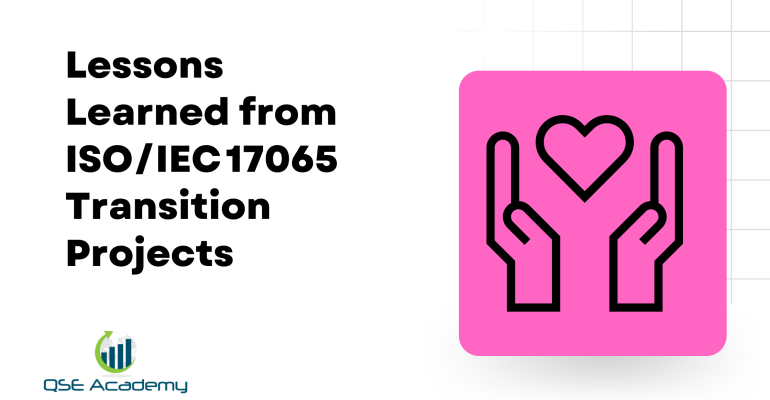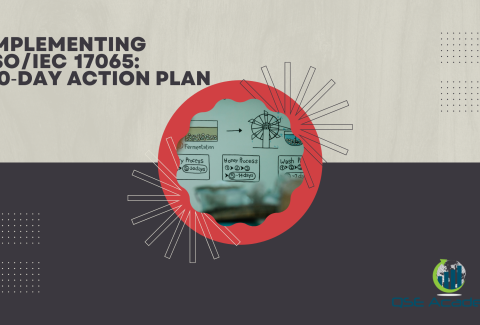Lessons Learned from ISO/IEC 17065 Transition Projects
What ISO/IEC 17065 Transition Projects Teach Us
Here’s what stood out every time I guided a certification body through ISO/IEC 17065 transition: no matter how prepared they felt, there were always hidden gaps. Transition projects reveal a lot about how organizations operate—how well teams communicate, how up-to-date documents really are, and how consistently processes are implemented.
Most certification bodies begin confident. Then they start mapping clauses and quickly realize the amount of work involved. Outdated schemes, missing impartiality evidence, weak decision separation, and inconsistent templates show up fast. These aren’t failures—they’re normal transition realities.
In this guide, I’m sharing the lessons that consistently show up across transition projects. These insights help you avoid predictable mistakes, move faster, and build a stronger, more compliant certification system.
Documentation Is Always More Outdated Than You Think
Every transition project starts with documentation. And every time, the same pattern appears: policies are updated, but forms and templates remain stuck in the old structure.
I’ve reviewed documentation sets that looked solid at first glance. But once we dug deeper, evaluation forms still referenced ISO Guide 65, scheme annexes used outdated sampling definitions, and decision records lacked revised clause references. This creates confusion during internal audits and external assessments.
The challenge isn’t just outdated wording—it’s inconsistent structure. People update the quality manual but forget that evaluators use daily operational forms that must align with updated requirements.
Pro Tip: Hold a “documentation sprint.” Update terminology and structure before doing deep compliance work.
Common Mistake: Updating high-level documents but leaving the working-level tools untouched.
Real Insight: A CB stalled its transition because its evaluation checklist contradicted the updated scheme. Correcting forms took more time than rewriting procedures.
 Impartiality Risks Are Often Hidden Until Audited
Impartiality Risks Are Often Hidden Until Audited
Impartiality is one of those areas that looks fine on paper until you really inspect it. Many certification bodies believe they have no conflicts, so they don’t document risks. But ISO/IEC 17065:2012 expects structured, evidence-based impartiality reviews.
Here’s where transition projects uncover problems: conflict-of-interest declarations aren’t updated, financial risk analysis isn’t documented, and impartiality committees rarely meet with clear agendas. The risk isn’t the absence of impartiality—it’s the absence of proof.
Pro Tip: Treat impartiality as an ongoing risk—not a one-time formality.
Common Pitfall: Believing “no conflict” is an acceptable answer without documented assessment.
Case Insight: A CB received a major NC because their impartiality committee existed in name only. No minutes. No risk analysis. Nothing recorded.
Decision Independence Is the Most Common Weakness
Decision independence is the Achilles’ heel of many certification bodies. ISO/IEC 17065:2012 draws a hard line between evaluation, review, and decision. But small teams often blur these roles without realizing it.
I’ve seen evaluators sign off on decisions “just to speed things up.” That shortcut kills independence. Transition reviews reveal these habits quickly.
Pro Tip: Create a decision matrix showing who evaluates, who reviews, and who signs decisions. Name backups too.
Common Mistake: Letting evaluators influence final decisions because “they know the file best.”
Real Example: One CB’s transition slipped when decision signatures were traced back to evaluators during peak workload. The auditor spotted it immediately.
Certification Schemes Need More Structure Than Most Realize
Certification schemes often look complete—until transition scrutiny begins. Many schemes lack defined sampling rules, documented decision triggers, surveillance logic, or version control.
When the scheme is vague, evaluators interpret criteria differently. That inconsistency becomes a major accreditation risk. A scheme must be detailed enough to guide day-to-day operations, not just outline high-level rules.
Pro Tip: Stress-test your scheme by reviewing an actual client file against it. You’ll find gaps faster.
Common Pitfall: Treating scheme documents as administrative instead of operational.
Short Case: A CB passed technical evaluation but failed scheme review because surveillance criteria weren’t defined clearly for different product categories.
Transition Is More About Communication Than Documents
You can update every procedure perfectly, but if your team doesn’t understand the new process, you’re still not ready. Transition success depends on communication, alignment, and training—not just writing documents.
Teams need clarity on what changed, why it matters, and how it affects their daily work. Without training, old habits return immediately.
Pro Tip: Train decision-makers separately. Their responsibilities are different and carry higher compliance risk.
Common Mistake: Assuming that announcing updates is enough. You need verification.
Real Insight: A CB avoided multiple findings because they ran scheme-readiness workshops. Evaluators practiced applying new rules together before full rollout.
Internal Audits Predict Your Accreditation Outcome
Internal audits tell you exactly how your accreditation assessment will go. When done properly, they uncover inconsistencies, outdated documents, and weak decision logic before the assessor sees them.
Transition projects show that many organizations underestimate the power of internal audits. They perform them mechanically instead of strategically.
Pro Tip: Include public-facing information in your internal audit scope. Accreditation bodies always check your website.
Common Pitfall: Closing non-conformities “on paper” without checking actual implementation.
Case Insight: A CB avoided a major NC after identifying outdated certification rules on their website during an internal audit.
Leadership Support Determines Transition Success
Transition projects succeed when leadership is involved. When leaders prioritize updates, allocate resources, and monitor progress, the transition runs smoothly. When they delegate the entire process to one person without authority, everything slows down.
Leadership needs to understand the risk of delays. Transition affects accreditation timelines, client confidence, and market credibility.
Pro Tip: Leadership should attend the first impartiality committee review after transition updates. It sends a clear message of commitment.
Common Mistake: Assigning transition work to one person without empowering cross-department coordination.
Real Insight: Strong leadership oversight reduced one CB’s transition duration by nearly 40%. They removed roadblocks, approved actions quickly, and supported training.
FAQs
What’s the biggest lesson from ISO/IEC 17065 transition projects?
Documentation alignment and impartiality risk management consistently determine readiness. If these two areas are clear, everything else is easier to fix.
How do small certification bodies handle decision independence?
They rotate responsibilities, use external reviewers when needed, or assign a dedicated decision gatekeeper to maintain independence.
Is it normal for transition to take longer than expected?
Absolutely. Most organizations underestimate time needed for updating scheme logic, training staff, and cleaning old templates.
Conclusion — Turning Lessons Into a Transition Strategy
ISO/IEC 17065 transition projects reveal patterns. Documentation gaps, hidden impartiality risks, weak decision independence, unclear schemes, poor communication, and lack of leadership focus are common—but all manageable when you know what to expect.
Over the years, I’ve seen well-planned transitions outperform rushed ones every time. When you apply these lessons, you move with clarity, avoid surprises, and enter your accreditation assessment confident and prepared.
If you want help turning these lessons into a personalized transition roadmap, I can build a structured action plan step-by-step.
Melissa Lavaro is a seasoned ISO consultant and an enthusiastic advocate for quality management standards. With a rich experience in conducting audits and providing consultancy services, Melissa specializes in helping organizations implement and adapt to ISO standards. Her passion for quality management is evident in her hands-on approach and deep understanding of the regulatory frameworks. Melissa’s expertise and energetic commitment make her a sought-after consultant, dedicated to elevating organizational compliance and performance through practical, insightful guidance.









